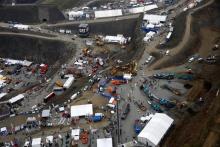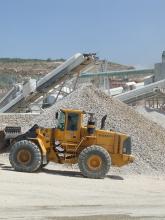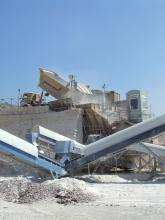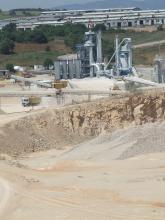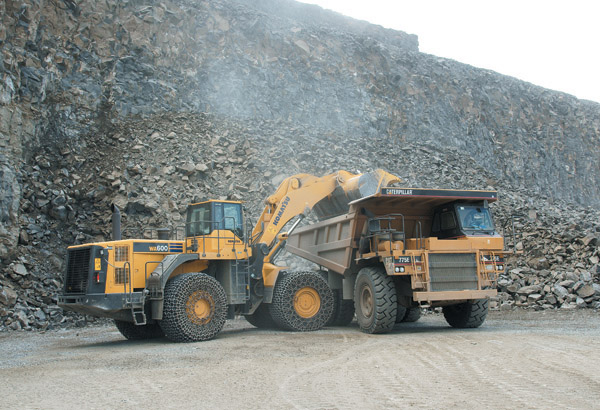
While Europe's quarrying industry will be heading to Neider-Ofleiden in Germany for Steinexpo in September, ABE has been taking a look at the quarry that hosts the tri-annual event
Once every three years, Mitteldeutsche Hartstein-Industrie AG (MHI) throws open the gates of its Neider-Ofleiden quarry near Marburg in Germany to host
The quarry at Neider-Ofleiden has a history dating back more than 100 years and today, in addition to its aggregates production, it also boasts an asphalt plant, recycling operations and landfilling work. The 160ha active site now produces around 800,000tonnes of virgin aggregates each year.
Volcanic past
The Vogelsberg region with its total area of more than 2500 km2 and its highest elevation of 773m is one of the largest extinct volcanoes world-wide, according to MHI. Over more than 10 million years enormous amounts of basalt lava broke to the surface to create the high quality rock that is now extracted at the Neider-Ofleiden quarry. Eruptions from the volcano ceased around 7 million years ago but the region's tempestuous past has left behind not only an attractive tourist region with many brooks, primeval forests and moors but also Europe's largest contiguous basalt deposit.
Work at the quarry in the Vogelsberg region, which is 70km north east of Frankfurt/Main started in 1906 and is MHI's largest operation (see box). When it first opened extraction was carried out by manpower but the quarry was an early adopter of mechanised methods and soon started to diversify its operation.
In 1935 MHI started to expand the range of products it offered with installation of the first asphalt production plant at the Nieder-Ofleiden site.
More extensions of the quarry boundary followed over the years to take the site to its current size, which not only qualifies it as Europe's largest basalt quarry but also to be one of the highest performing quarrying companies in that region and it is an area that is not really lacking in extractive industries.
Qualified workforce
Over the last three decades MHI Nieder-Ofleiden has extended its activities into diverse new business segments, which has helped it to prosper despite tough economic conditions in the German construction market over the last decade or more. Though the core business
is still the extraction and processing of basalt, the company also uses its broad construction material know-how, the existing stock-piling capacities and former quarrying zones to enlarge its product and service programme.
Today MHI Nieder-Ofleiden employs in total 46 people, but not all these work directly at the quarry face, this total includes administration and materials testing staff. More than half - around 27 in total - are working directly in the aggregates production part of the business. Because of the diversified segments in which it operates, the Nieder-Ofleiden management attaches great importance to the qualification of their employees and some of them have been working within the company for many years. This emphasis on qualification not only applies for the production technologies, according to technical director Wolfgang Münch. "We explicitly want to promote the health and safety awareness in our company, because our parallel and often interconnected procedures really do create high demands in that field." And the company has been quite successful in this area - last December the company received the health and safety certificate "Sicher mit System", which means systematically safe, from the German professional association of the quarrying industry. Apart from organisational measures, the safety experts that reviewed the operation pointed out the high safety standards, which MHI applies to machinery and plants and the personal equipment of its staff.
High production
Some 800,000tonnes of raw basalt aggregates are extracted per year in Nieder-Ofleiden. The active quarrying area comprises around 25ha, spread over three floors with bench heights of 25 to 30m.
Extraction is carried out using conventional blasting techniques according to demand, but usually one or two times per week with up to 30,000 tonnes of rock blasted each time. Drilling of the blast holes to up to 30m depths with a diameter of 92mm is carried out by a tracked mobile
The loading is carried out alternatively by a
The quarry roads in Nieder-Ofleiden are specifically well maintained to improve cycle times and they are even partially surfaced with asphalt right into the loading areas on the quarry floors. Consequently the 4x4 trucks achieve high transfer speeds even uphill to the primary crusher which guarantees a high productivity in transport.
In the short term the management is investing in even more efficient transport technology: both of the rigid dump trucks are to be replaced by to new 50tonne machines soon. "The 50/50-combination better matches our production organisation and we're expecting a 15 to 20% reduction in energy costs using the most modern machine technology," explained Münch. The decision clearly mirrors the dramatic rise in production costs seen in quarries right across Europe during the last few months.
The feeder for the primary crusher is situated right above the large processing plant, on the same level as the upper quarry floor. An extensive asphalt surfaced access area and near by buffer zones help to minimise the discharge stops.
The blasted stone is fed to the primary crusher Nordberg C145, which has a feed opening of 1200 by 1100mm and produces a 0/300mm grade material with a capacity of 4500tonnes per hour. Via underground conveyor, the material is transported to the two-stage processing plant.
The processing plant, built in 1996, incorporates two separate production lines (gravel/splitt and edelsplitt) and still applies to high standards in terms of quality and environmental protection. The four crushers and the 2 by 3 production screens, with the adjacent silos for storage of 15 intermediate and end products (6000m³ in total), are fully enclosed. Dust created during the crushing and screening processes is absorbed by a high-performing filter unit (BMD-Garant) with an air capacity of 2 times 120,000m³ per hour.
For secondary and tertiary crushing operations, there are four crushers producing the gravel fractions 0/80mm and 0/32mm and material 0/22mm for the edelsplitt-line. The site's crushers include a Sandvik H 6000, a Lokomo G158, a
Based on its high-quality basalt stone, with a compressive strength of 147 to 225Mpa,
MHI Nieder-Ofleiden covers the complete range of mineral aggregates and mixtures for the road and civil engineering industry and the edelsplitt and crushed sand qualities for asphalt and concrete production. Maximum delivery distances are between 30 and 50km from the quarry, depending on products.
Far greater delivery distances are achieved for the railway ballast that is produced in Nieder-Ofleiden. As normal or washed material, the MHI-Basalt meets the quality specification of the German railway operators Deutsche Bahn AG for normal and high-speed track systems. It is not unusual for such material to be transported up to 250km for this use and is delivered using block trains at the company-owned on-site-terminal. "We've even delivered railway ballast up to the Baltic Sea area," said Münch. But the transport distances are not really the challenge in that business. "The real challenge is meeting the just-in-time material demands of serial construction projects which can call for up to 30,000tonnes of material within only two weeks."
MHI has successfully met these challenges and in the last few years the centrally located site became the biggest single ballast supplier in the area of the old Laender (former Federal Republic of Germany).
Asphalt
Asphalt production at MHI Nieder-Ofleiden has had a long tradition - the first facility dates back to the mid-thirties. For the first five decades it mainly provided profitable on-site-refinement of the company's own raw materials, but for the last 20 years the company has used modern techniques and group-owned production technologies to achieve not only economical but also ecological "added-value" with recycling facilities. MHI has not revealed the actual production volumes of its asphalt plant but ABE can confirm that it is substantial.
As a German premiere in 1985, MHI equipped its Nieder-Ofleiden plant with a parallel drum for the production of recycled asphalt and in doing so created a new business area. Today, large quantities of used asphalt are delivered to the quarry by third parties for reprocessing and up to 60% recycled content makes MHI an important player in the regional recycling system for construction materials.
Accordingly, MHI produces all traditional hot mixes for binder and base layers with particularly high recycling-content with a maximimum production rate of 200tonnes per hour. As another recycling product the company offers also cold mixes. During this year a new 1ha storage area for used asphalt will be installed with a direct connection to the asphalt production plant. Some 12,000tonnes of milled asphalt will then be stocked under cover for future processing.
Like all asphalt plants in the MHI Group, Nieder-Ofleiden also produces reduced temperature asphalts, using the additive aspha-min(r). The natrium-alluminosilicate zeolite allows a 30°C reduction of the mixing temperature and accordingly up to 30% energy savings. Reduced laying temperatures with good workability also minimize exposition on road construction sites. Aspha-min had been developed in MHI-Group's laboratories some 10 years ago, meets all relevant specifications and is today marketed Europe-wide in co-operation with a road construction partner company.
Recycling
For many years MHI Nieder-Ofleiden has also been active in the recycling of construction materials or industrial residuals through the disposal of soil and contamination-free industrial waste. The quarry uses this material for the refilling of former extraction zones.
The quarry receives around 260,000tonnes of this type of material each year. Beside soil material, which is being mainly used for restoration purposes, the company also reprocesses demolition concrete using mobile crushing plants to provide base material for road construction and civil engineering. The company's mobile crushers are also used to recycle blast furnace slag to be mainly used in road construction applications.
Another important field is the controlled disposal of industrial residuals and waste of mineral origin. In co-operation with a specialist company, MHI deposits moulding sands from steel foundries in a mono-deposit on the site. The co-operation has existed since 1981 and up to now some 4million tonnes of the non-problematic foundry-residuals were placed in the quarry in order to restore former extraction zones.
MHI will now meet the long-term demand of the regional foundry industry with an extension of the existing disposal site. The controlled drainage of the moulding sand terraces on the impermeable basalt ground will be guaranteed by a new 204m long drainage tunnel. Construction started in July this year. When finished the walk-in drainage tunnel will lead surface water from the lowest no longer active quarry floor without pumping to adjacent parts of the site.
Showtime
Every three years Nieder-Ofleiden plays host to the Steinexpo quarrying exhibition but the show is not part of MHI's business area.
"MHI is not involved in the organisation of the show, but every three years we turn the open surfaces of the quarry floor over to Steinexpo's disposal. All operative measures, beginning with planning, organisation and realisation and the approval from the corresponding authorities are the full responsibility of the show's organiser Geoplan and its partners," explained MHI technical director Wolfgang Münch. "We only have the very pleasant role of hosting the show and to welcome the European quarrying industry into our quarry to meet with the global manufacturers of mobile and stationary quarry technologies. It is of course a good opportunity to meet with all our own customers, suppliers and competitors for an interesting exchange of ideas during the event." Nieder-Ofleiden first hosted Steinexpo in 1990 and five events have since been held there but the arrival of the show means far more than just temporarily leaving the quarry floors 'naked'. Indeed the demonstration-show does affect the operational planning of the quarry to a certain extent. Beginning in March and April of a Steinexpo year, the quarrying activities start to follow a pattern to create the space needed for the event, which takes place on all three active floors of the MHI quarry. The plans not only include creating the space needed, but also the material required for the 170 or so 'active'
stands that allow the equipment to be demonstrated in a live environment. In total 30,000tonnes of raw material will have to be provided in several stocks in the four demonstration areas.
Steinexpo is an "operation within the operation", according to Münch. It is necessary to gain temporary approval from the mountain authority for the live demonstrations and is linked to similarly severe standards that are applied to a normal quarry operation. This approval for the show period plus another four weeks for the build-up of stands and two weeks for the dismantling period is obtained by the organisers Geoplan themselves. Geoplan's managing director is Dr Friedhelm Rese who has a PhD in mining engineering which has helped the company to understand the complexities of putting on such a show.
In detailed planning, Geoplan is supported by an expert team from the Mining Institute of the Technical University of Clausthal in Germany. Since 1999, this proven collaboration has helped with the internal logistics of organising Steinexpo by co-ordinating work between MHI and Geoplan.
"We co-operate very well with the experts from Clausthal," said Münch. "Within the erection period it is mainly shortages in loading and transport capacities that have to be avoided. In the week of the event, which this year is between 3 and 6 September, production activities stop completely but we are still able to meet orders during this period by taking material from pre-prepared stockpiles. Another two weeks are planned for dismantling the show when specific measures have to be taken to ensure the safe simultaneous operation of quarrying and show logistics." For the first time this year, Steinexpo will include the European Championships of Truck-Trial. On a separately prepared course in the overburden zone right above the show area some 50 participants from 10 European countries will measure their skills in driving extreme off-road trucks through mud and rubble and over steep ramps.
According to Münch, preparations for Steinexpo 2008 are well in hand.


